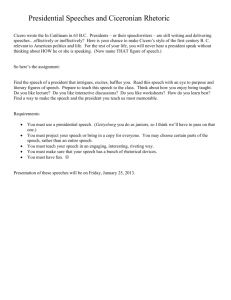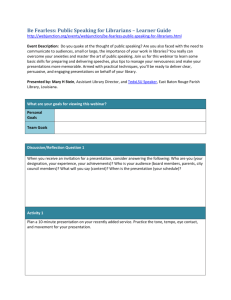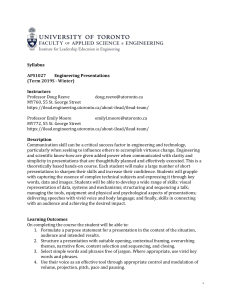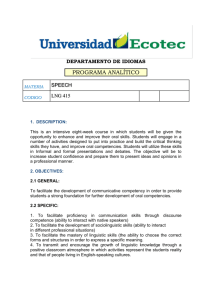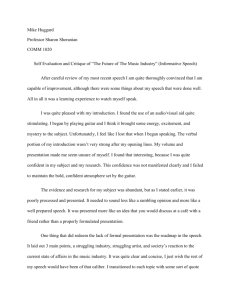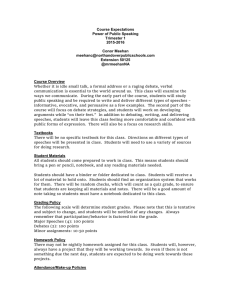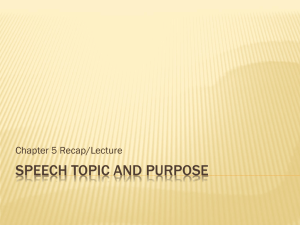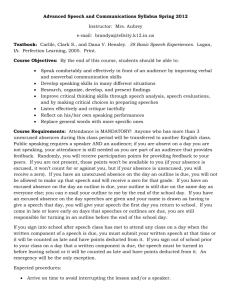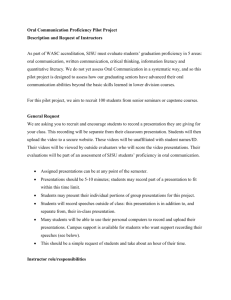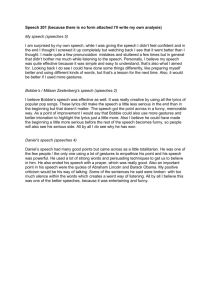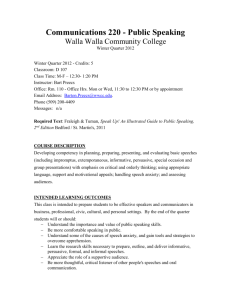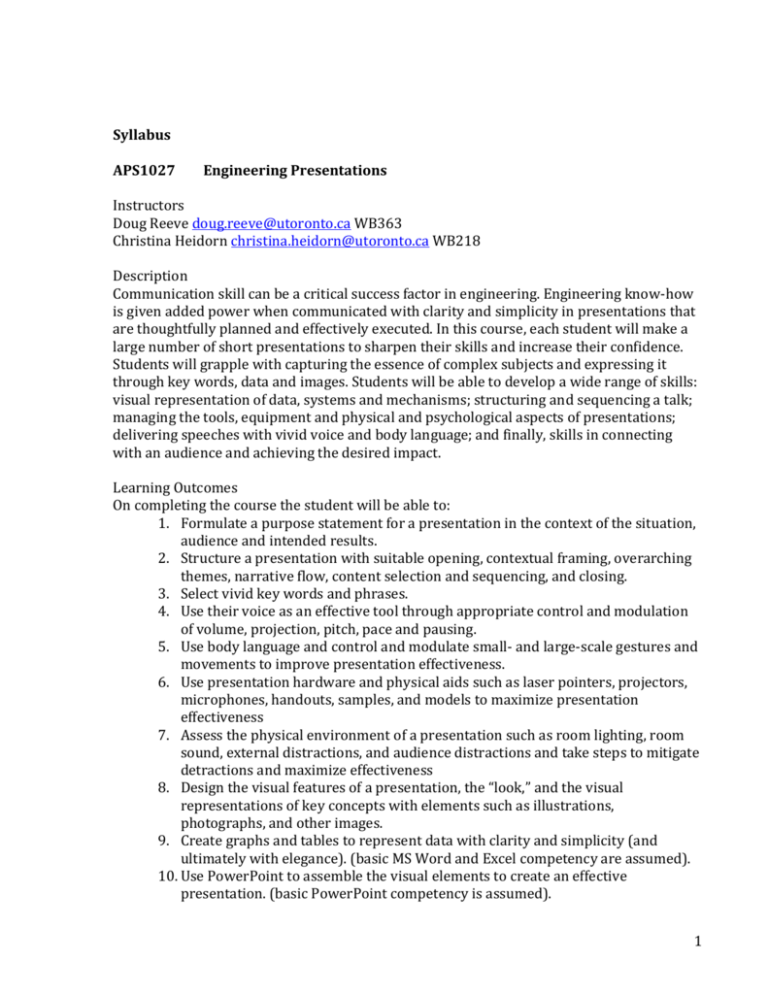
Syllabus
APS1027
Engineering Presentations
Instructors
Doug Reeve doug.reeve@utoronto.ca WB363
Christina Heidorn christina.heidorn@utoronto.ca WB218
Description
Communication skill can be a critical success factor in engineering. Engineering know-how
is given added power when communicated with clarity and simplicity in presentations that
are thoughtfully planned and effectively executed. In this course, each student will make a
large number of short presentations to sharpen their skills and increase their confidence.
Students will grapple with capturing the essence of complex subjects and expressing it
through key words, data and images. Students will be able to develop a wide range of skills:
visual representation of data, systems and mechanisms; structuring and sequencing a talk;
managing the tools, equipment and physical and psychological aspects of presentations;
delivering speeches with vivid voice and body language; and finally, skills in connecting
with an audience and achieving the desired impact.
Learning Outcomes
On completing the course the student will be able to:
1. Formulate a purpose statement for a presentation in the context of the situation,
audience and intended results.
2. Structure a presentation with suitable opening, contextual framing, overarching
themes, narrative flow, content selection and sequencing, and closing.
3. Select vivid key words and phrases.
4. Use their voice as an effective tool through appropriate control and modulation
of volume, projection, pitch, pace and pausing.
5. Use body language and control and modulate small- and large-scale gestures and
movements to improve presentation effectiveness.
6. Use presentation hardware and physical aids such as laser pointers, projectors,
microphones, handouts, samples, and models to maximize presentation
effectiveness
7. Assess the physical environment of a presentation such as room lighting, room
sound, external distractions, and audience distractions and take steps to mitigate
detractions and maximize effectiveness
8. Design the visual features of a presentation, the “look,” and the visual
representations of key concepts with elements such as illustrations,
photographs, and other images.
9. Create graphs and tables to represent data with clarity and simplicity (and
ultimately with elegance). (basic MS Word and Excel competency are assumed).
10. Use PowerPoint to assemble the visual elements to create an effective
presentation. (basic PowerPoint competency is assumed).
1
11. Analyze great/historic speeches to articulate the methods used in
writing/delivering
12. Design a presentation for a remote audience using tools such as Skype or WebEx.
13. Evaluate a presentation and assess its effectiveness (including self-evaluation)
14. Formulate and deliver feedback to a presenter (including self-feedback).
15. Devise a methodology for preparation of a presentation including planning
content and all elements of form, practicing and previewing.
16. Appreciate the importance of cross-cultural communication.
17. Listen to questions and respond directly.
18. Ask questions of a presenter in a manner that adds to the collective knowledge of
all listeners.
Teaching Methods
1. Prepared short speeches on engineering subjects, illustrated and not, informative
and persuasive
2. Prepared short speeches: an elevator pitch, a chalk talk, a toast, and an introduction
3. Very short speeches for practicing basic skills: voice, pace, gestures, body language,
etc.
4. Video recording and review of speeches (pre- and post-course)
5. Homework such as readings, video viewing, speech analysis and speech preparation.
6. Viewing, reading, analyzing and re-delivering great/historic speeches
7. Exercises and homework preparing graphs, tables and diagrams - hand drawn and
computer drawn.
8. Self- and peer-evaluation of, and feedback on, presentations
9. Workshops using participatory techniques such as Pictionary and “improv.”
10. Written assignments such as: analysis of a speech, a speech for a formal occasion, a
speech for a personal occasion, a reflection on the challenges of presentations.
11. Extemporaneous speeches
12. Lectures
Textbook
Canadian Public Speaking by Melanie Novis, Pearson/Prentice Hall, 2004
Evaluation
Visual Aids
Mid-term Presentation
Written Assignments
Final Presentation
Graded work
Week 1
Week 3
20%
20%
30% (assigned and in-class)
30%
Written one-minute speech introducing yourself
Informative Technical Speech
(written bullet-point outline and speech)
Other Sources
2
Books
“Made to Stick: Why Some Ideas Survive and Others Die” by Chip Heath and Dan Heath,
2008
Website: heathbrothers.com
“The Oxford Dictionary of Quotations” edited by Elizabeth Knowles, 7th Edition, 2009
“Lend Me Your Ears – Great Speeches in History” selected and introduced by William Safire,
2004
“Engineering Communication: From Principles to Practice” by Robert Irish and Peter Eliot
Weiss, 2009
Websites
The Three-minute Thesis
The original started by the University of Queensland: http://threeminutethesis.org/
The Ontario3MT Competition: http://3mt.mcmaster.ca/
The Alan Alda Institute for Communicating Science
The Flame Challenge
3

